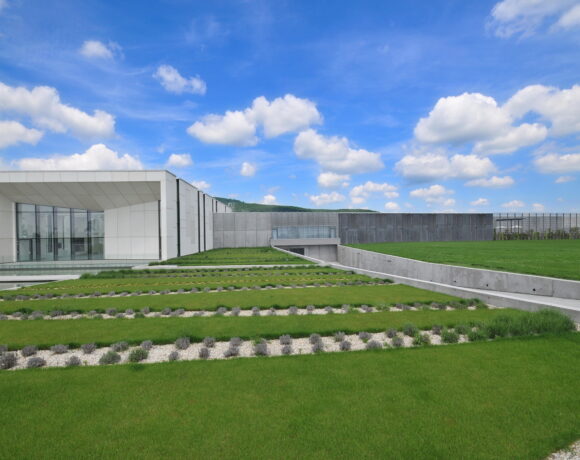The Secession Building is a cubic building surmounted by a pediment, with floral decorations in gold of great visual impact. It was built between 1897 and 1898 on a project by the young architect Joseph Maria Olbrich, exponent of the Secession, as well as a pupil of the already famous Otto Wagner. It was built as with the intention of hosting the exhibitions of contemporary authors and somehow belonging to anti-academic currents and it is still used for this purpose. On the front of the building the epigraph “Der Zeit ihre Kunst der Kunst ihre Freiheit” (To each age its art, to art its freedom) appears, a slogan that is still unsurpassed and very topical today.
The famous “Beethoven Frieze” (considered apex point of Viennese Art Nouveau), housed in the underground part of the Secession Building, was created by Gustav Klimt on the occasion of the XIV exhibition of the Austrian Artists Association (1902) and that edition reached 60 thousand visitors.
In line with the original intentions and with the motto stamped on the facade, the Secession Building is carrying out an exhibition program with an international orientation, presenting important variations of contemporary artistic expressions with personal or thematic exhibitions. To all intents and purposes, the Secession Building is the oldest independent exhibition space in the world, expressly dedicated to contemporary art, and it is still managed by an artistic association.
Until February 7, the Secession Building hosts two noteworthy exhibitions. The first is dedicated to the work of Edi Hila (Shkodra, 1944, lives in Tirana) whose career was hampered by the regime of the People’s Socialist Republic because his work was not considered in line with the dictates of socialist realism and he could free himself from these obstacles only with the collapse of that political power. His images concern change, hope and frustration, the inventiveness and creativity of ordinary people, the struggle for survival and democracy, the vindication of values and social objectives. Architecture and the urban environment provide him with the settings and the substratum of his speech, through testimonies of everyday life. Working on thematic series allows him to present the respective topics in a complete and multifaceted way, experimenting with the respective formal and compositional variations.
In the exhibition “Der Klang der Tuba” (The Sound of the Tuba), Hila presents about twenty paintings, starting with the works created in the late nineties. The works cover a time span that links today’s global migrations to politically motivated deportations in the first phase of communism in Albania. In Hila’s images, the present and the past are on an equal footing and, despite the different conditions, each work displays a surprising number of parallels and invites reflection on today’s conditions.
The second exhibition concerns a set of video installations by Lawrence Abu Hamdan (born in 1985 in Amman, lives in Dubai). Lawrence Abu Hamdan deals with sound, language, documentation, memory and the search for truth in the context of the legal and humanitarian crises of the present. In the current exhibition (“Green Coconuts and Other Inadmissible Evidence”) four works are exhibited, divided into two subgroups, which deal with the subject of testimony in legal terms and somehow breaks the front of silence and pushes towards other forms of testimony and denunciation. For example, the audiovisual installation After SFX (2018) emerged from an investigation into the Syrian Saydnaya prison undertaken in 2016 together with Amnesty International and Forensic Architecture. Abu Hamdan interviewed the former prisoners and created with their contribution a sound document on the prison, which was supposed to provide information on the architecture of the building, the living conditions inside, the torture performed there, the number of prisoners, and so on. Lawrence Abu Hamdan’s work (which was also exhibited at the latest documenta) is supported by the Alserkal Arts Foundation.
Fabio Fabris
Info:
until 7 Feb 2021
Edi Hila. “Der Klang der Tuba”
Lawrence Abu Hamdan. “Green Coconuts and Other Inadmissible Evidence”
Secession
Friedrichstr. 12, Wien
da mar a dom h 14.00 – 18.00
office@secession.at
 Edi Hila, Der Klang der Tuba, 2020, vista della mostra al Palazzo della Secessione. Foto Oliver Ottenschläger, courtesy Secession
Edi Hila, Der Klang der Tuba, 2020, vista della mostra al Palazzo della Secessione. Foto Oliver Ottenschläger, courtesy Secession
 Edi Hila, Municipalité de Tirana, 2011, oil on canvas, 105 x 175 cm, ph courtesy Galerie Mitterrand, Paris
Edi Hila, Municipalité de Tirana, 2011, oil on canvas, 105 x 175 cm, ph courtesy Galerie Mitterrand, Paris
 Lawrence Abu Hamdan, Once Removed, 2019, vista dell’installazione al Palazzo della Secessione, 2020. Foto Iris Ranzinger, courtesy Secession
Lawrence Abu Hamdan, Once Removed, 2019, vista dell’installazione al Palazzo della Secessione, 2020. Foto Iris Ranzinger, courtesy Secession
 Lawrence Abu Hamdan, After SFX , 2018, vista dell’installazione alla Palazzo della Secessione, 2020. Foto Iris Ranzinger, courtesy Secession
Lawrence Abu Hamdan, After SFX , 2018, vista dell’installazione alla Palazzo della Secessione, 2020. Foto Iris Ranzinger, courtesy Secession

is a contemporary art magazine since 1980






NO COMMENT